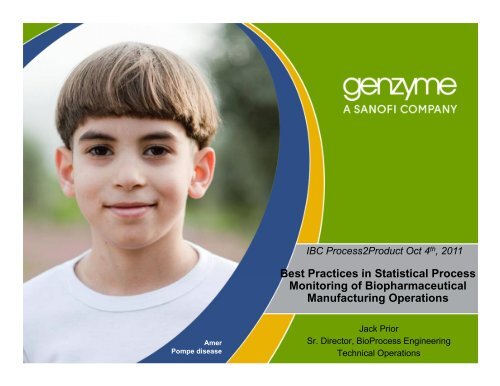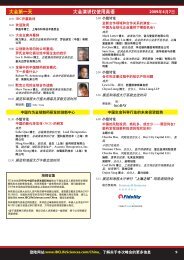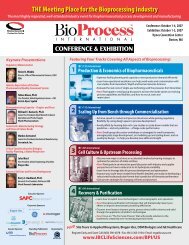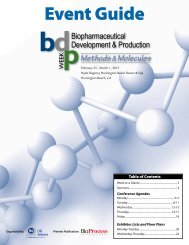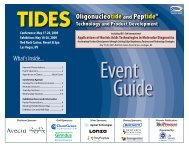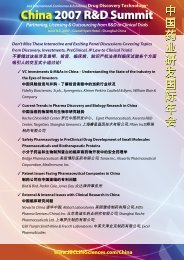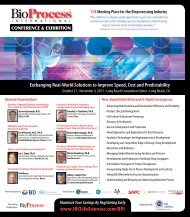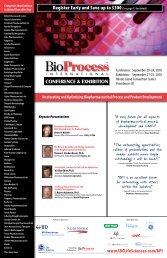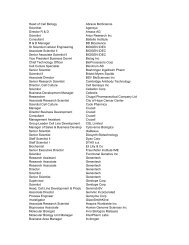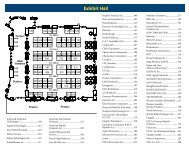Best Practices in Statistical Process Monitoring ... - IBC Life Sciences
Best Practices in Statistical Process Monitoring ... - IBC Life Sciences
Best Practices in Statistical Process Monitoring ... - IBC Life Sciences
You also want an ePaper? Increase the reach of your titles
YUMPU automatically turns print PDFs into web optimized ePapers that Google loves.
<strong>IBC</strong> <strong>Process</strong>2Product Oct 4 th , 2011<br />
<strong>Best</strong> <strong>Practices</strong> <strong>in</strong> <strong>Statistical</strong> <strong>Process</strong><br />
Monitor<strong>in</strong>g of Biopharmaceutical<br />
Manufactur<strong>in</strong>g Operations<br />
Amer<br />
Pompe disease<br />
Jack Prior<br />
Sr. Director, Bio<strong>Process</strong> Eng<strong>in</strong>eer<strong>in</strong>g<br />
Technical Operations
BPOG Out of Trend/<strong>Statistical</strong> <strong>Process</strong> Control<br />
Work<strong>in</strong>g Group<br />
● Steve Jones (BPOG)<br />
● Bill Henry (GSK)<br />
● Kev<strong>in</strong> Legg (Genzyme)<br />
● Brian Stamper (MedImmune)<br />
● Janet Alvarado (Merck)<br />
● Monica Jungen (Merck-Serono)<br />
● Paul McCormac (Pfizer)<br />
● Christoph Hoh (Sanofi)<br />
● Dave Hopk<strong>in</strong>s (Genzyme)<br />
● Jarrod Medeiros (Merck-Serono)<br />
● Michael Warncke (Bayer)<br />
● Cenk Undey (Amgen)
Orig<strong>in</strong>s:<br />
BPOG Data Analysis Work<strong>in</strong>g Group<br />
● BioPhorum Operations Group (BPOG)<br />
– 13 companies & ~300 participants<br />
– Collaborat<strong>in</strong>g on biopharmaceutical MFG challenges<br />
– “Po<strong>in</strong>t Share” organized on Data Analysis (October 2010, Boston, MA)<br />
– Case studies/discussion: process monitor<strong>in</strong>g, platforms/tools, organizations<br />
● Po<strong>in</strong>t Share Observations<br />
– Struggl<strong>in</strong>g with similar challenges<br />
– Diverse approaches <strong>in</strong> place and contemplated<br />
– Companies <strong>in</strong> process of def<strong>in</strong><strong>in</strong>g SPC practices & standards<br />
● Follow-up Focus on SPC and OOT<br />
– Teleconferences<br />
– Internal surveys<br />
– <strong>Best</strong> practice shar<strong>in</strong>g<br />
– How can we summarize….<strong>Process</strong>2Product
Converg<strong>in</strong>g Drivers for Formal <strong>Statistical</strong> <strong>Process</strong><br />
Monitor<strong>in</strong>g<br />
Bus<strong>in</strong>ess<br />
Drivers<br />
Technical<br />
Support<br />
Mission<br />
cGMP<br />
Requirements<br />
Lean<br />
Avoid Surprises<br />
Preempt OOS<br />
Global supply cha<strong>in</strong>s<br />
CMO/tech transfers<br />
Biosimilars<br />
QbD<br />
Understand<br />
Control Improve<br />
Cont<strong>in</strong>uous<br />
<strong>Process</strong><br />
Verification<br />
ICH<br />
Q10<br />
Cost<br />
2011
SPC Driver - FDA Validation Guidance:<br />
Cont<strong>in</strong>ued <strong>Process</strong> Verification<br />
● Cont<strong>in</strong>ually assure the commercial process rema<strong>in</strong>s <strong>in</strong> a state of control<br />
● Establish ongo<strong>in</strong>g program to analyze product and process data<br />
Recommends…<br />
● Data statistically trended and reviewed by tra<strong>in</strong>ed personnel<br />
● Statisticians/equivalent with adequate SPC tra<strong>in</strong><strong>in</strong>g develop plans<br />
● Quality unit review<br />
http://www.fda.gov/downloads/Drugs/GuidanceComplianceRegulatoryInformation/Guidances/UCM070336.pdf
SPC Driver - ICH Q10:<br />
Pharmaceutical Quality System<br />
● “…plan and execute system for monitor<strong>in</strong>g of process performance and<br />
product quality…”<br />
● “Analyze parameters and attributes identified <strong>in</strong> control strategy to verify<br />
cont<strong>in</strong>ued operation with<strong>in</strong> a state of control”<br />
● “…cont<strong>in</strong>ued capability of processes and controls…”<br />
● “…data management and statistical tools”<br />
● “…identify sources of variation for cont<strong>in</strong>uous improvement”<br />
● “…enrich the design space”
Goals of Effective SPC Program<br />
● Efficient and proactive management of process<br />
o Enhance quality compliance and process understand<strong>in</strong>g<br />
o Preempt deviations, don’t generate them<br />
● Balanced focus on process parameters and analytics<br />
o Focus effort on critical areas<br />
o Reduce effort on non-critical items<br />
“Have the appropriate people look<strong>in</strong>g at the appropriate data<br />
analyzed <strong>in</strong> the appropriate way respond<strong>in</strong>g <strong>in</strong> the<br />
appropriate manner”, Kev<strong>in</strong> Legg, Genzyme
Key Questions Raised <strong>in</strong> Work<strong>in</strong>g Group<br />
on SPC implementation Strategy<br />
1. How to decide what to formally trend<br />
2. How to respond to OOT Signals<br />
3. How to manage OOT Response<br />
4. How to def<strong>in</strong>e “out of trend”<br />
5. How to set (and reset) limits and on what reference data<br />
6. How to deal with “unusual” basel<strong>in</strong>e data<br />
7. How to choose what statistical rules to apply<br />
8. How to learn more
1. How to Choose which Variables to Trend<br />
● Def<strong>in</strong>e <strong>Process</strong> Control Strategy (PCS) 1<br />
– Break process <strong>in</strong>to def<strong>in</strong>ed steps with def<strong>in</strong>ed purposes (the “why” vs. “how”)<br />
– Classify <strong>Process</strong> Control Elements (CPP, KPP, CQA, CI, PI…)<br />
● PCS shapes monitor<strong>in</strong>g strategy & signal response<br />
– Formally trend/monitor CQAs (IPCs, ISs, Specs) and CPPs<br />
– Set proportionate formality/response for process and consistency <strong>in</strong>dicators<br />
1<br />
A planned set of controls, derived from<br />
current product and process understand<strong>in</strong>g<br />
that assures process performance and<br />
product quality. (ICH Q10).<br />
Paul MaCormac, Pfizer
2. How to Respond to OOT Signals:<br />
Specification, Action, and <strong>Statistical</strong> Control Limits<br />
Specification Limit: “Voice of Customer”<br />
Set based on process<br />
capability, regulatory<br />
expectations and<br />
product safety concerns<br />
Action Limits:<br />
PV Acceptance Criteria,<br />
Batch record limits<br />
<strong>Statistical</strong> Control Limit: “Voice of <strong>Process</strong>”<br />
+/- 3 for n> 15 and/or PpK ≥ 1.33<br />
Set based on<br />
process characterization<br />
and/or large scale data<br />
Paul MaCormac
2. How to Respond to OOT Signals:<br />
Potential Map from PCS Classification to Signal Response<br />
Variable<br />
Acceptable<br />
Range<br />
Normal Operat<strong>in</strong>g<br />
Range<br />
<strong>Statistical</strong> Control<br />
Limits<br />
Attributes<br />
CQAs*<br />
Specification/IS<br />
In-<strong>Process</strong> Control (IPC)<br />
Consistency Indicator<br />
(later)<br />
<strong>Process</strong> Indicator<br />
(real-time)<br />
Critical<br />
Deviation<br />
Major<br />
Deviation<br />
deviation<br />
N/A<br />
N/A<br />
Technical review<br />
DCS Alarm<br />
OOT/ APR Review<br />
Immediate alert<br />
OOT / APR Review<br />
Immediate alert<br />
Technical review<br />
Immediate alert<br />
Aggregate as CI<br />
Potential MVA**<br />
Parameters<br />
Critical <strong>Process</strong><br />
Parameter (CPP)*<br />
Key process parameter<br />
(highly controlled)<br />
Non-KPP(nKPP)<br />
(no step impact)<br />
Major<br />
Deviation<br />
deviation<br />
DCS Alarm<br />
DCS Alarm<br />
Technical review<br />
Potential MVA<br />
Technical review<br />
Potential MVA<br />
*Def<strong>in</strong>ed <strong>in</strong> ICH Q8<br />
**Multivariate Analysis
3. How to Manage OOT Response<br />
Survey comments<br />
● QC Lab<br />
– If no confirmed lab error, QC triggers deviation<br />
– If lab error, <strong>in</strong>itial result <strong>in</strong>validated after new result obta<strong>in</strong>ed<br />
– Lab error sometimes only detected <strong>in</strong> CI calculation (e.g. yield outliers)<br />
● <strong>Process</strong> Parameters & Consistency Indicators<br />
– Manufactur<strong>in</strong>g, technical, or (sometimes) validation responsibility<br />
– Immediately enter <strong>in</strong> quality system OR trigger discussion<br />
– OOT below a set “performance level” can be agreed as non-concern<br />
– If uncovered dur<strong>in</strong>g APR, <strong>in</strong>vestigation may be launched<br />
● Frequency of Data Review<br />
– Automate/alert after each discrete observation if possible<br />
– Cross-functional notification can facilitate resolution<br />
– Periodic data reviews for cont<strong>in</strong>uous data (e.g. run reviews)<br />
– Formal evaluation may not occur until APR
3. How to Manage OOT Response<br />
Team Structure<br />
● Basis for Extent of Investigation<br />
– Risk assessment & variable classification<br />
– Potential impact to process performance and product quality<br />
– Upfront work <strong>in</strong> <strong>Process</strong> Control Strategy (PCS) guides actions
4. How to Def<strong>in</strong>e “Out of Trend”<br />
● Variation not expla<strong>in</strong>ed by a s<strong>in</strong>gle distribution of process output 1<br />
● Violation of the Western Electric or Nelson trend<strong>in</strong>g rules 2<br />
● Result from a process not associated with random variation<br />
● Visual review .. .outside 3 …discretion of lab management<br />
● Can vary by site or group with<strong>in</strong> site (i.e. QC vs. manufactur<strong>in</strong>g)<br />
…Consensus on +/- 3 limits… but from what data set<br />
1. MJ Kiemele et al. Basic Statistics: Tools for Cont<strong>in</strong>uous Improvement.4 th Edition<br />
2. NIST/SEMATECH e-Handbook of <strong>Statistical</strong> Methods, http://www.itl.nist.gov/div898/handbook /<br />
04MAY2011
5. How and When to Def<strong>in</strong>e Control Limits<br />
● Choose right reference data set…<br />
– After ~15-30 batches from stable process (Shewhart recommends 25+)<br />
– Use <strong>in</strong>terim provisional limits from process validation criteria<br />
– Use largest dataset representative of current process & test<strong>in</strong>g<br />
● Exclude Outliers…<br />
– Remove known root (special) causes<br />
– Use objective outlier exclusion methods<br />
– Use judgement -> tighter limits (conservative, defendable, appropriate)<br />
– Show outliers even if excluded from calculations<br />
● Revisit/adapt when needed…<br />
– When known process or analytical change impacts mean or variability<br />
– As APR recommendation or <strong>in</strong> change control<br />
– Can shift mean but reta<strong>in</strong> long term variance
6. How to Handle Unusual Data<br />
Situation<br />
“out of control”<br />
historical data<br />
“non-normal”<br />
historical data<br />
LoQ assays<br />
(e.g. LaL, purity)<br />
Strategies/Comments<br />
• Exclude special cause variability<br />
• Incorporate all common cause variability<br />
• Short horizon reference range often too narrow<br />
• Utilize mov<strong>in</strong>g range for control limit calculations.<br />
• 3 limits often apply 1<br />
• Avoid complex WE/Nelson rules<br />
• Transform data prior to apply<strong>in</strong>g rules<br />
• Visually <strong>in</strong>spect trends <strong>in</strong>stead<br />
• If sufficient data is available >LoQ, exclude
7. When & How to use Western Electric/Nelson Rules<br />
Detect<strong>in</strong>g Common vs. Special Cause Variation<br />
Short Horizon<br />
Common Cause<br />
• Assay noise<br />
• Raw materials<br />
• Procedural noise<br />
Long Horizon<br />
Common/Special Cause<br />
(Not visible <strong>in</strong> 25 po<strong>in</strong>ts)<br />
• Lab transfers<br />
• Reagent lots<br />
• Personnel<br />
• Column pack<strong>in</strong>g<br />
• Upstream productivity<br />
• Plant utilization<br />
Special Cause<br />
• Operator errors<br />
• Equipment failures<br />
• Sample handl<strong>in</strong>g<br />
• Data typos/calibration<br />
• Material <strong>in</strong>stability<br />
● Data rarely “<strong>in</strong>dependent and identically distributed”<br />
● Real processes trend/move - result<strong>in</strong>g <strong>in</strong> false signals<br />
● 3 and 2/3 outside 2 rules OK - complex rules often <strong>in</strong>appropriate<br />
● Backward look<strong>in</strong>g rules impact earlier lots<br />
● Trend signals slow <strong>in</strong> bio environment (e.g. 6 batches <strong>in</strong> a row)<br />
● Value of well-tra<strong>in</strong>ed eyes on right parameters
8. How to Learn More<br />
● Regulatory Guidance<br />
– ICH Q9<br />
– International Conference on Harmonization (ICH) Q10: Section 3.2<br />
– ICH Q11 (Draft): Section 3.2, Section 6.1<br />
– New <strong>Process</strong> Validation Guidance<br />
http://www.fda.gov/downloads/Drugs/GuidanceComplianceRegulatoryInformation/Guidances/UCM070336.pdf<br />
● <strong>Statistical</strong> <strong>Process</strong> Control<br />
– DS Chambers, D Wheeler, Understand<strong>in</strong>g <strong>Statistical</strong> <strong>Process</strong> Control<br />
– DC Montgomery, Introduction to statistical quality control. 6 th Ed.<br />
– MJ Kiemele et al, Basic Statistics: Tools for Cont<strong>in</strong>uous Improvement. 4th Ed.<br />
– NIST/SEMATECH e-Handbook of <strong>Statistical</strong> Methods,<br />
http://www.itl.nist.gov/div898/handbook / 04MAY2011<br />
– William A. Lev<strong>in</strong>son, <strong>Statistical</strong> <strong>Process</strong> Control for Real-World Applications, CRC Press
Summary:<br />
Key Success Factors <strong>in</strong> SPC Implementation<br />
● Infrastructure<br />
– Data management to enable trend<strong>in</strong>g and ensure data <strong>in</strong>tegrity<br />
– Appropriate state of control to enable decisions based on trended data<br />
● Quality Systems & Bus<strong>in</strong>ess <strong>Process</strong>es<br />
– Proper OOT def<strong>in</strong>ition, notification methods, and proportional response<br />
– Def<strong>in</strong>ed responsible parties to ensure timely response to OOT<br />
● <strong>Process</strong> Control Strategy<br />
– Appropriate risk-based classification of parameters and attributes<br />
– <strong>Statistical</strong> tools/methods to ensure right limits and rules applied<br />
– Focus on prevent<strong>in</strong>g deviations<br />
– Knowledge capture


